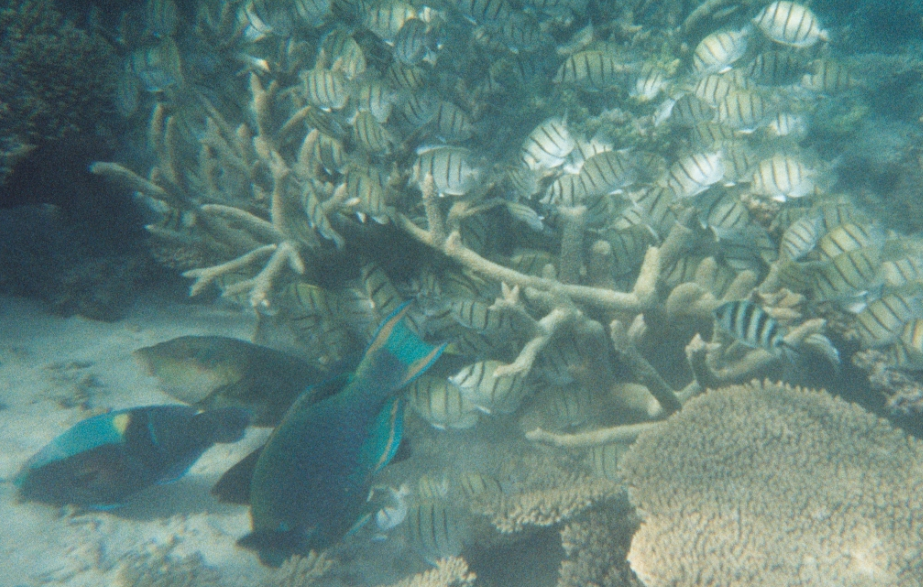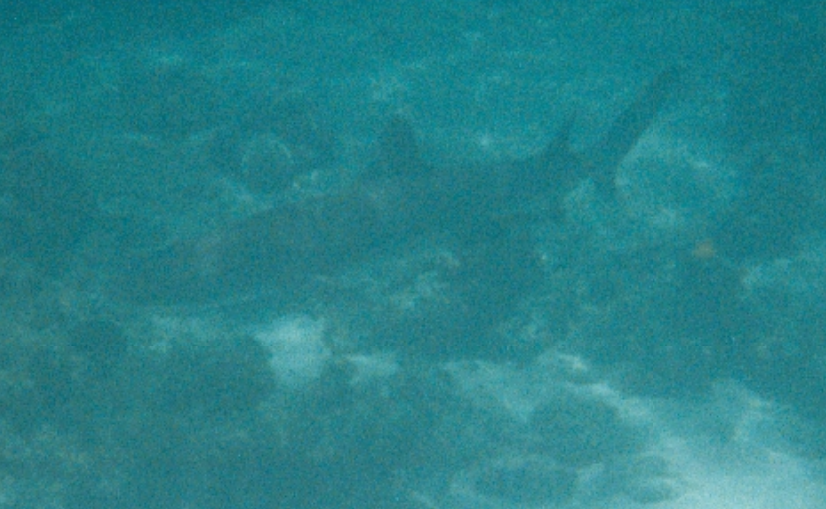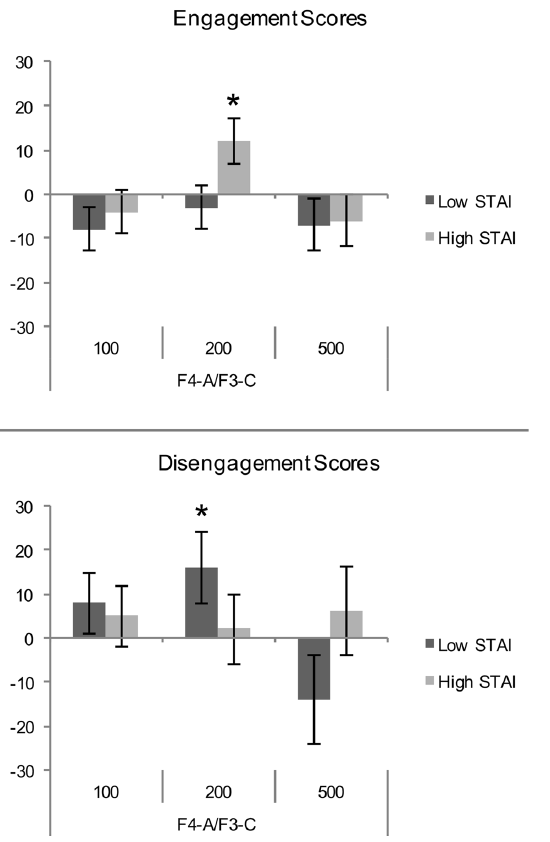Imagine settling into the well-deserved holiday on the Ningaloo Reef. The Indian Ocean is warm and gentle and you go for your first exploratory snorkel. The corals are beginning to recover from their latest bleach and the number and coloring of the tropical fish is as enchanting as it is astounding.

And then you take another look around you….

Where would you focus your attention?
And for how long?
Eventually, your rational self will catch up with the instant emotional response, and you will recognize this ominous figure as a relatively harmless reef shark. Reef sharks rarely present a danger to humans. (I took the above pictures, and that wasn’t my only encounter with a reef shark, so they can’t be that dangerous.)
But before the rational self kicks in, a lot of interesting cognitive processing occurs, and some of that processing is expressed as an attentional bias for threat. Those biases span a range of different behaviors, depending on how long the threatening stimulus remains present.
At very short presentation times (100-200 ms), people tend to exhibit facilitation—that is, their attention is drawn to the threatening stimulus and they respond to it more quickly than to a neutral stimulus. When the presentation duration is longer (up to half a second), people show difficulties disengaging from the threatening stimulus. We find it hard to ignore the shark once its silhouette has emerged from the ocean around us. When presentation time is longer still, people ultimately tend to show attentional avoidance—we refuse to look back at the shark.
What are the specific brain regions and processes involved in this attentional bias for threat?
A recent article in the Psychonomic Society’s journal Cognitive, Affective, & Behavioral Neuroscience addressed this question. Researchers Laura Sagliano, Francesca D’Olimpio, Lorella Izzo, and Luigi Trojano were particularly interested in hemispheric differences in the brain’s threat response.
It has long been known that the prefrontal cortex is a key structure for the processing of emotional stimuli. It has also been hypothesized that the left and right prefrontal cortex play different roles in processing, with negative emotions mapping preferentially onto right-hemisphere processing and positive emotions mapping onto the left hemisphere.
Sagliano and colleagues took advantage of transcranial direct current stimulation (tDCS) to selectively modulate cortical activity of the two hemispheres. tDCS involves application of a current to the participant’s skull via electrodes. A unique attribute of tDCS is that the polarity of the effect can be manipulated: when positive (“anodal”) stimulation is delivered, the neuronal excitability of the area being stimulated increases, whereas when negative (“cathodal”) stimulation is applied, neuronal excitability decreases.
The experimental task is shown in the figure below. Participants had to indicate via keypress whether the black dot appeared on the left or the right of the screen. The dot was preceded by an attentional cue. On 80% of all trials, the cue was valid (top row in figure) and indicated what side the dot would appear on. On the remaining 20% of trials the cue was invalid (bottom row).

In the above figure, the cue involved a threatening stimulus (here it was a dog, but other threatening stimuli involved a gun, a group of armed boys, and so on). Sagliano and colleagues also included non-threatening cues, such as picture of a window or a cup.
For the analysis, the response times (RT) were combined across types of cues for the valid and invalid trials separately. An engagement score was computed by considering only the valid trials (because engagement there was rewarded by the target being in the anticipated location). RT for the threatening cues were subtracted from the RT for nonthreatening cues, such that a positive engagement score reflected faster orientation to the threatening stimulus.
A disengagement score was computed for the invalid trials (because there people had to disengage from the cue and shift attention to the opposite side). For this score, RTs for the nonthreatening cues were subtracted from the RT with threatening cues, such that a positive disengagement score indicated that people had greater difficulty disengaging from the threatening stimulus.
Crucially, while participants performed a series of such trials, their frontal cortex was asymmetrically stimulated, as shown in the figure below.

The red squares indicate anodal (positive) stimulation and the black squares represent cathodal (negative) stimulation. By selectively stimulating one hemisphere while depressing activity in the other, Sagliano and colleagues sought to identify the asymmetric roles of the prefrontal hemispheres in the processing of threat stimuli.
The results were complex and nuanced and cannot be recounted in full here. The figure below shows one interesting aspect of the results that were gathered when the right hemisphere was positively stimulated (the condition represented in panel d in the immediately preceding figure).

The figure shows that under those stimulation conditions, significant attentional biases arose at intermediate presentation durations (the numbers 100, 200, and 500 refer to presentation times in milliseconds). Intriguingly, those effects differed depending on participants’ level of trait anxiety (STAI in the figure above).
Anxious individuals showed an engagement bias—that is, they were faster to orient towards the threatening cues than the nonthreatening cues. For non-anxious individuals, the reverse was true: they showed no engagement bias but had difficulty disengaging their attention from threatening stimuli.
When interpreting these results, it must be borne in mind that they only arose with a specific pattern of tDCS; namely, when the right hemisphere was excited and the left hemisphere inhibited. When no stimulation was present or the opposite asymmetry of tDCS was applied, no attentional biases were observed. In other words, a threat bias emerged only when the right hemisphere was asymmetrically stimulated—exactly as predicted on the basis of previous research which had tentatively assigned negative emotions preferentially to right-hemisphere processing.
Because STAI scores correlate with measures of depression, it is possible that the results of Sagliano and colleagues extend beyond the narrow domain of trait anxiety level. Although it remains to be confirmed empirically, the asymmetric tDCS applied here may also affect other biases related to depression.
And for your next excursion to the Ningaloo reef, pack some cathodal stimulation for your right prefrontal cortex.
Psychonomics article focused on in this post:
Sagliano, L., D’Olimpio, F., Izzo, L., & Trojano, L. (2017). The effect of bicephalic stimulation of the dorsolateral prefrontal cortex on the attentional bias for threat: A transcranial direct current stimulation study. Cognitive, Affective, & Behavioral Neuroscience, 17, 1048-1057. DOI: 10.3758/s13415-017-0532-x.

